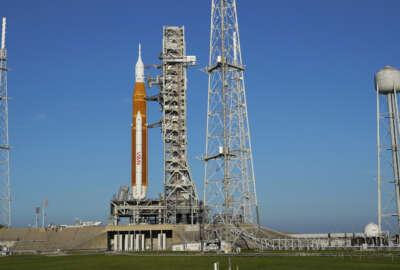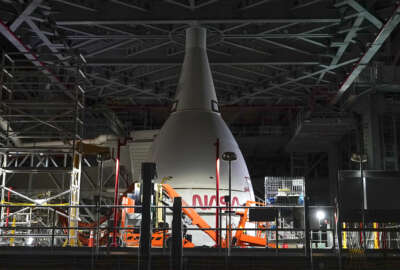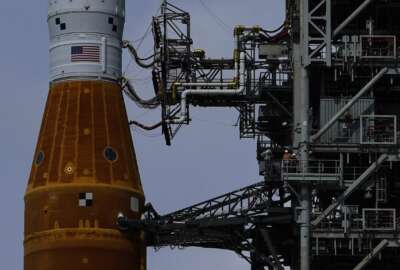Hubbard Radio Washington DC, LLC. All rights reserved. This website is not intended for users located within the European Economic Area.
GAO: NASA’s Artemis 3 moon landing timeline unrealistic
The closer NASA gets to returning to the moon, the farther away the moon seems to move. Contractors on the Artemis 3 project are having trouble with some basic ...
The closer NASA gets to returning to the moon, the farther away the moon seems to move. Contractors on the Artemis 3 project are having trouble with some basic items, like the spacesuits astronauts would need and the lunar lander itself. The Government Accountability Office has found that NASA may be too ambitious in its schedule for the initial launch. For more on the findings, Federal Drive Host Tom Temin spoke with Bill Russell, GAO’s director of contracting and national security.
Interview transcript:
Tom Temin And you’ve looked at this from time to time and you’re reporting there is some progress on the contractors part, but it sounds pretty basic if they can’t get the spacesuit done. I mean, what’s going on? What’s the latest findings here?
Bill Russell One thing for context: This is incredibly complex. It’s the first time we’ve tried to return to the moon in over 50 years. There’s a reimagining of how to do that, not just to do one moon landing, but to create a sustained lunar presence and ultimately set the foundation for human exploration of Mars. So I think that that ups the complexity a little bit. But what we found, to your point, is that NASA’s initial schedule is very ambitious when you compare it to the average time it takes equivalent NASA projects to go from start to finish. And we found it is about a year faster than the average NASA project, even though there are extra complexities like being able to support humans safely, some of the technical challenges in fueling the lander, getting into orbit, testing that all to meet a 2025 launch date.
Tom Temin Right. So you’ve got a lander and then you’ve got the crew capsule that takes them up there. Then you’ve got the heavy lift rocket. Then you have the spacesuits that the astronauts have to wear. These are all being developed by industry on behalf of NASA, correct?
Bill Russell Correct. We did take a look at the arrangements between NASA and the contractors and found that there is robust insight into the contractors’ activities, especially around how they’re handling safety issues and the progress that they’re making. So the transparency and the relationship between NASA and the contractors was good.
Tom Temin All right. So what are the chief technical problems then? What’s going on, say, with the lander? Because that’s kind of essential. If you can’t land, you can’t get to the moon. And the capsule can orbit, but that doesn’t do you much good for establishing something permanent.
Bill Russell Absolutely. I think the initial testing issues encapsulate some of the setbacks. So you saw in recent weeks Space X did an orbital flight test that was more successful than the first one, but still didn’t fully meet the objectives. They need to do that a number of times to demonstrate the capability of just using the rocket with the lander coupled to get into orbit. Once you do that, there are other steps. So that’s the baseline. You have to get that out of the way and then you can move on to more technically challenging aspects. For example, the current concept of operations calls for basically launching a gas station in low earth orbit, right? So the lander goes, it would have to dock with the fueling station, transfer propellant and then ultimately get to the moon and then be in orbit there to dock with the Orion crew capsule. So that’s no easy feat. There’s work to be done to demonstrate that capability. All of that takes time. As you learn from one test, you have to then reschedule and get the [Federal Aviation Administration] certifications, other things that you need to do the next test.
Tom Temin So it sounds like the architecture of this program, though, is significantly more complicated because each linkage and each component kind of multiplies the complexity relative to the original space program back in the 1960s.
Bill Russell Exactly. And that’s getting back to the earlier point: This is really a platform to be able to go to the moon multiple times, support multiple missions. Artemis is planned to extend into the 2030s. So it’s more complicated than a-one-and-done approach. And these capabilities are going to be foundational to supporting that larger, sustained effort.
Tom Temin We’re speaking with Bill Russell. He’s director of Contracting and National Security Issues at the Government Accountability Office. And what does NASA say with respect to why they shaved a year off their plan relative to the — as you report — 79 months these types of complex plans normally take?
Bill Russell Well, that was their initial schedule. The analysis of the 13 months is really based on the work that we did comparing that schedule to the average NASA major project. NASA has said that the human landing system schedule is under review. That process is ongoing.
Tom Temin Well, with respect to launching in 2025, that’s not going to happen, is it?
Bill Russell Our estimation is that it will not.
Tom Temin And does NASA agree with that estimation?
Bill Russell They’re looking at those scheduled dates right now, but they’re aware of the challenges that we point out in this report.
Tom Temin Right. And so what were your recommendations then? How do you simply give yourself more time? Is it a matter of just re-baselining the time, which also means re-baselining the money?
Bill Russell Right. And we didn’t have any specific recommendations to NASA for this report. We’ve pointed out in previous reports the need to to look at the integration across all of these systems. You have the Orion crew capsule has to work with space launch system, human landing system. So it’s a lot of moving pieces to pull off the Artemis 3 moon landing. For this report, it’s really just to show the schedule compression and some of the technical challenges that are outstanding to achieve the eventual mission.
Tom Temin And you have different contractors developing these different components. And that’s a little different from the old days when NASA’s built many things in-house by hand with its own people. And is that an issue or do the contractors make sure that they’re compatible with one another? I mean, there’s only one specification that’s applicable to one of these types of programs. And so they all have to work in concert in some ways. Is NASA able to orchestrate that?
Bill Russell We did take a look at that issue and found that so far so good in terms of being able to convey what the requirements are for these systems. The spacesuits is a good example of that. The contractors, Axiom, NASA had originally designed the updated spacesuit and then handed that to Axiom to take to the finish line. There’s still some design challenges, technical challenges to create the new space suit to support the moon landing mission. There’s a lot of aspects like life support and things that really have to be perfected. But that’s one example of NASA’s shifting from doing something in-house to having a contractor do it. We did look at the contracts and the terms that allow NASA to still have good visibility and found that those were robust.
Tom Temin And getting back to Space X, they just had a launch that didn’t go — as you said, it went better than the last time, which blew up. This one also exploded, I think, eventually. So they’re getting there, but at some point, just getting one done — oh, good, it didn’t explode — that probably doesn’t meet NASA’s criteria for can we do this repeatedly and safely? I mean that sounds pretty important.
Bill Russell That’s right. And that speaks to the volume of the remaining work and the complexity of it. You have to demonstrate multiple times the ability to get the lander into orbit and then, as I said, move to the next phase, which shows you can dock the lander with that fuel depot that’s already in space, transfer propellant, and then demonstrate that you can get it to lunar orbit. So all of those things remain to be done.
Tom Temin Fundamentally, is this realistic that it can all actually happen?
Bill Russell I do think it’s realistic. And there’s progress that’s being made. It’s just getting from where we are now to successful launch in 2025. That’s the part that seems overly ambitious.
Tom Temin Yeah, in some ways, this is like a combination of the Apollo program and the space shuttle program in terms of just all the working parts to it.
Bill Russell That’s right. There are a lot of systems that have to work together seamlessly in a new and novel way.
Tom Temin And NASA’s pretty much on board with what it is. Again, no recommendations, but you’re kind of finding things that they don’t disagree with.
Bill Russell Exactly.
Copyright © 2024 Federal News Network. All rights reserved. This website is not intended for users located within the European Economic Area.
Tom Temin
Tom Temin is host of the Federal Drive and has been providing insight on federal technology and management issues for more than 30 years.
Follow @tteminWFED
Related Stories
Related Topics





